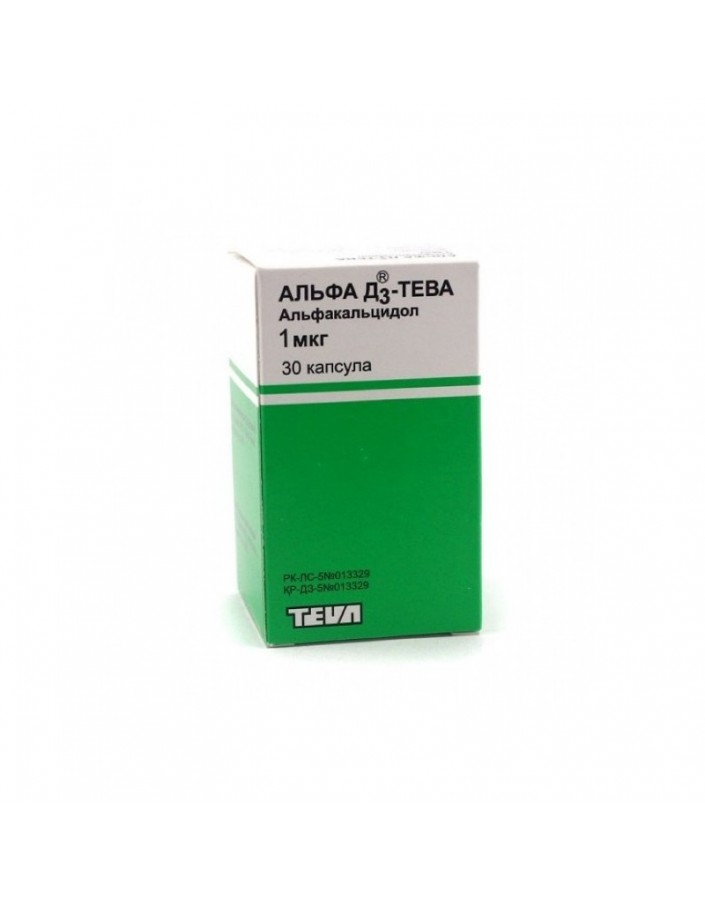



ALPHA DZ-TEVA CAPSULES 1 MG - 30 pcs

Security policy (edit with Customer reassurance module)

Delivery policy (edit with Customer reassurance module)

Return policy (edit with Customer reassurance module)
Ingredients: alfacalcidol 1 mcg excipients: anhydrous citric acid; propyl gallate; vitamin E; absolute ethanol; peanut butter capsule composition: gelatin; glycerin 85%; anidsorb 85/70; food ink black A10379 Release form: 1 mcg capsules - in a blister, 10 pcs.; in a pack of cardboard 1 blister or in polypropylene bottles of 30 pcs.; in the box 1 bottle.
Regulating calcium-phosphorus metabolism, compensating for vitamin D deficiency
Osteoporosis (including postmenopausal, senile, steroid); osteodystrophy in chronic renal failure; hypo-, pseudo-hypo-and hyperparathyroidism (with bone lesions); rickets and osteomalacia associated with malnutrition or malabsorption; hypophosphatemic vitamin D-resistant and pseudo-deficient (vitamin D-dependent) rickets and osteomalacia; Fanconi syndrome (hereditary renal acidosis with nephrocalcinosis, late rickets and adiposogenital dystrophy); renal acidosis.
Inside, 1 time per day (in the morning). The duration of the course is determined by the doctor individually and depends on the nature of the disease and the effectiveness of therapy. In some cases, the drug is used throughout life. Adults: with rickets and osteomalacia due to exogenous vitamin D deficiency,gastrointestinal tract diseases or long-term anticonvulsant therapy - 1–3 mcg / day. When hypoparathyroidism - 2-4 mg / day. With osteodystrophy, with chronic renal failure - 0.25–2 mg / day. In Fanconi syndrome and renal acidosis, 2–6 mcg / day. With hypophosphatemic rachitis and osteomalacia - 4–20 mcg / day. With osteoporosis - 0.5–1 mg / day. Treatment is recommended to start with the minimum of these doses, controlling 1 time per week the level of Calcium and phosphorus in the plasma. The dose can be increased by 0.25–0.5 mcg / day to stabilize the biochemical parameters. Children weighing less than 20 kg - at 0.01–0.05 mcg / kg / day, weighing 20 kg or more - 1.0 mcg / day. In case of renal osteodystrophy, the dose is 0.04–0.08 mcg / kg / day.
Hypersensitivity, hypercalcemia, hyperphosphatemia (except those with hypoparathyroidism), hypermagnemia, vitamin D intoxication, breastfeeding.
With care prescribed to patients prone to hypercalcemia, especially those suffering from urolithiasis. During the period of use of the drug, it is necessary to regularly (at least 1 time in 3 months) monitor plasma calcium and urine levels, monitor the development of the therapeutic effect and, if necessary, adjust the dose to avoid the development of hypercalcemia and hypercalciuria. In the presence of biochemical signs of normalization of the structure of the bone (normalization of the content of alkaline phosphatase in plasma), a corresponding reduction in the dose of the drug is necessary, thus avoiding the development of hypercalcemia.Hypercalcemia or hypercalciuria can be corrected by discontinuing the drug and reducing calcium intake to normalize its plasma concentration. As a rule, this period is 1 week. Then therapy can be continued, starting at half the last dose taken.
List B.: At a temperature not higher than 25 ° C.